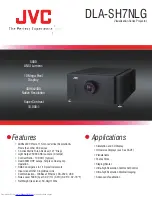
BASIC OPERATION
CP2000-X User Manual
3-5
020-100031-01 Rev . 1 (03-2009)
Projection Head
The projection head houses all critical illumination and optical components as well as
the
DLP
Cinema
processing technology responsible for combining light and
incoming source signals into brilliant high-resolution cinema displays. Cinema
source inputs connect to the rear of the projector; non-cinema connects to the
underside of the projector. Projector function is controlled via the TPC or other
communication link from either an Ethernet or RS232 controller. The projection head
is closed and locked for normal operation.
Security Locks
TAMPER-RESISTANT HIGH-SECURITY for PROJECTION HEAD:
Components in the
projection head are protected by a electronically monitored high-security lock on the
lid. This interlock strictly controls access, since every opening of the lid is 1)
electronically logged and reported and 2) will immediately disable the current
CineLink
®
2
cinema presentation. The unlocked state is reported via a TPC alarm
window, serial communication and SNMP (note the latter requires the “TPC-60”
model of the
Touch Panel Controller
, new in 2006). You must lock the lid in order to
remove the key and activate the switch for normal operation. The two identical keys
provided at manufacture are unique to your projection head serial number as
identified on the back of the Christie key fob, and cannot be duplicated. If you lose or
damage a key, contact your dealer or Christie for a new security lock and key set—
the keys cannot be replaced individually.
NOTES:
1)
The high-security interlock requires a Type 3 Interface Board and main
projector software v10.0.30 or higher.
2)
It is recommended that all keys to the
projector be kept in a locked cabinet at the site.
Other CP panels are not removable with standard tools, or they can be removed only
where there are other obstacles in place that prevent theft or tampering.
Touch Panel Controller (TPC)
The
Touch Panel Controller (TPC)
is a portable touch-sensitive screen used to
control the projector. At the TPC, general users can turn the lamp on/off, select a
specific source/input as defined in one of 32
display setups
created by the installer,
and obtain basic status. It is typically mounted on the rear of the projector or at some
other convenient nearby location, and connects to the 6-pin XLR connector on the
projector’s
Communications and Source Connection Panel
. Tilt/turn the TPC as
desired for best viewing angle, and use a small knob on the back to adjust its screen
brightness. Navigation and description of the
TPC
menus—including password-
protected options—is fully explained in
3.5, Using the Touch Panel Controller
.
NOTE:
This is a typical manual power-up procedure. Cinema installations may
include an automation system for controlling projector start-up and lamp ignition in
conjunction with other variables such as lighting, audio, etc
WARNINGS
Do not attempt operation if the AC supply
is not within the specified voltage range.
3.2 Power-up
Procedure
Summary of Contents for CP2000-X
Page 1: ...CP2000 X U S E R M A N U A L 020 100031 01...
Page 2: ......
Page 42: ......
Page 102: ......
Page 112: ......
Page 130: ......
Page 135: ...SPECIFICATIONS CP2000 X User Manual 8 5 020 100031 01 Rev 1 03 2009...
Page 160: ......
















































